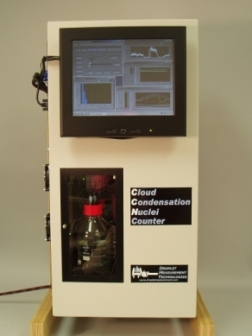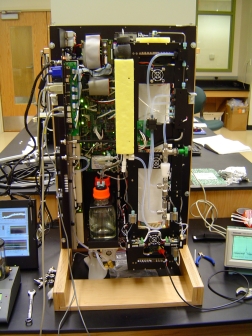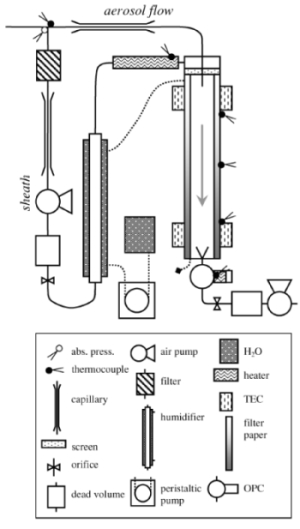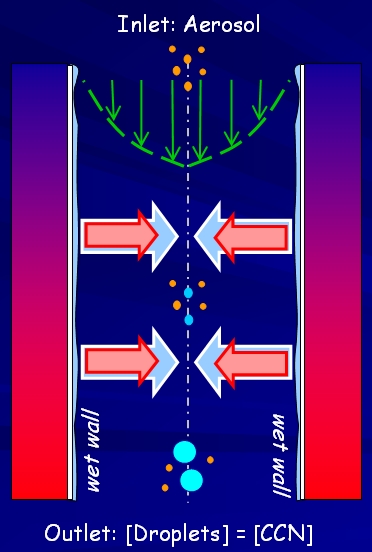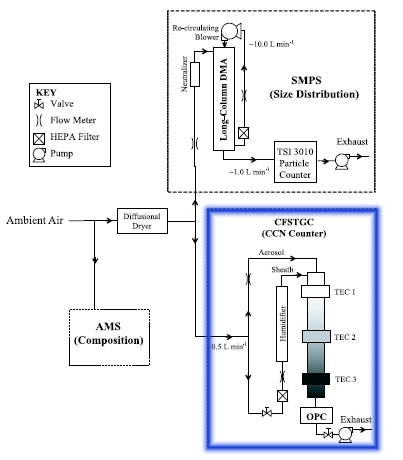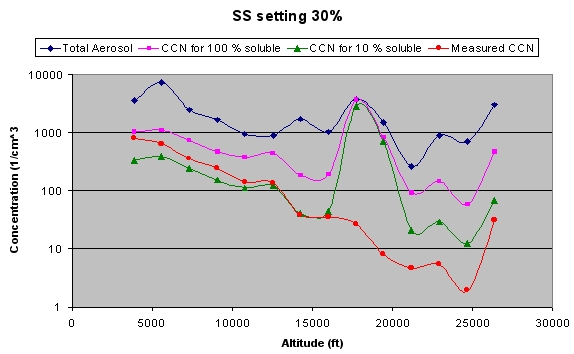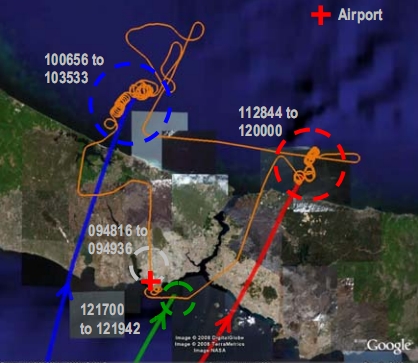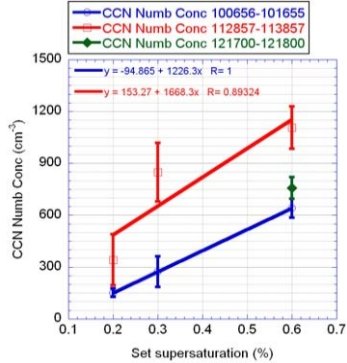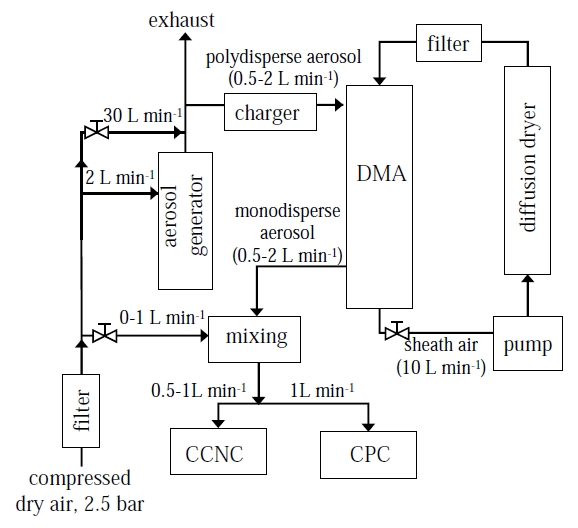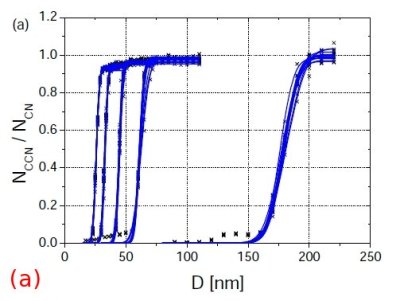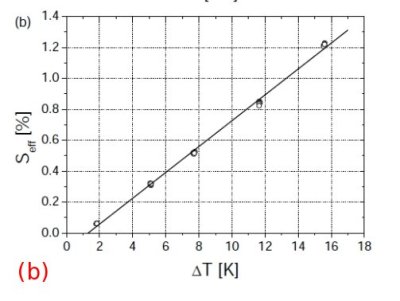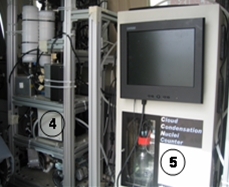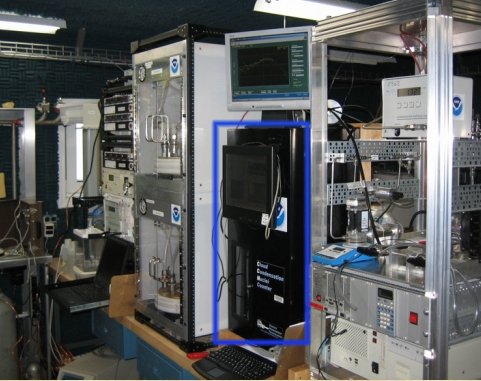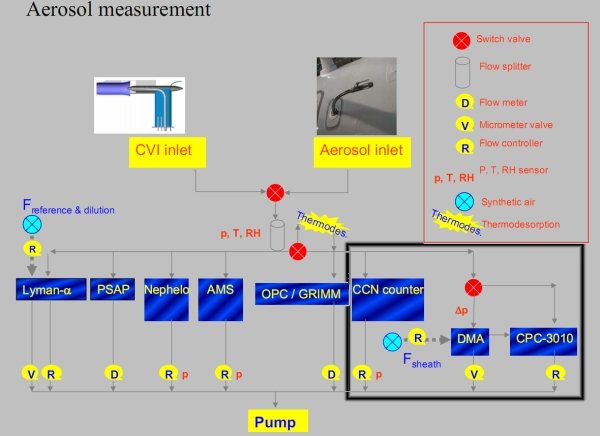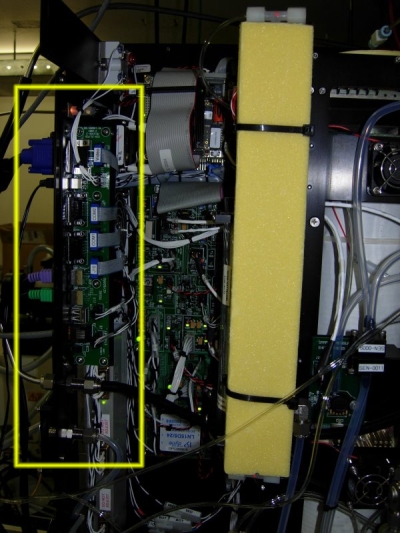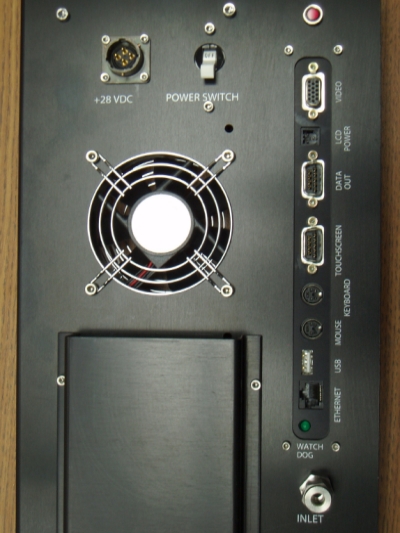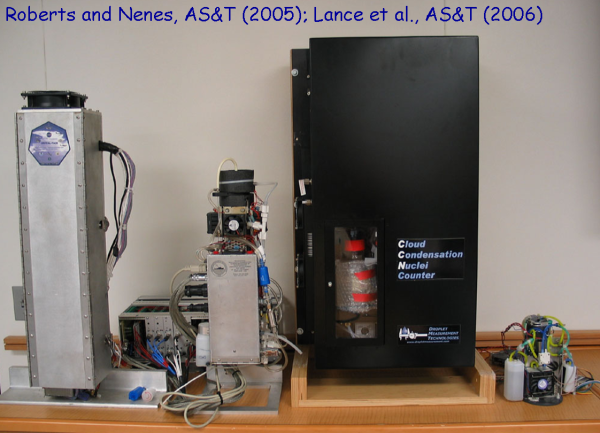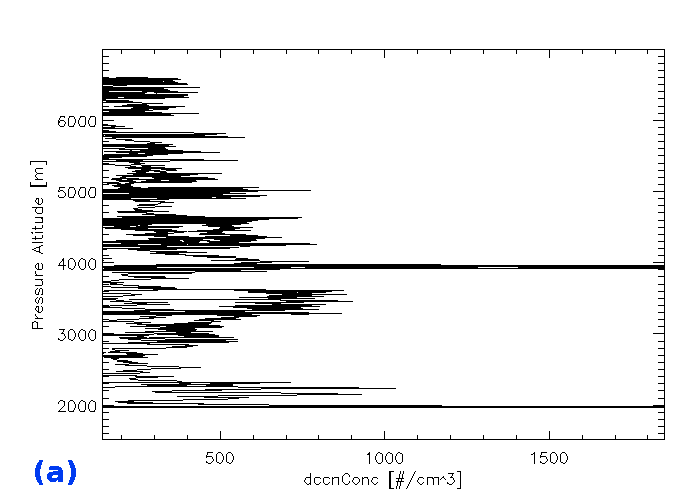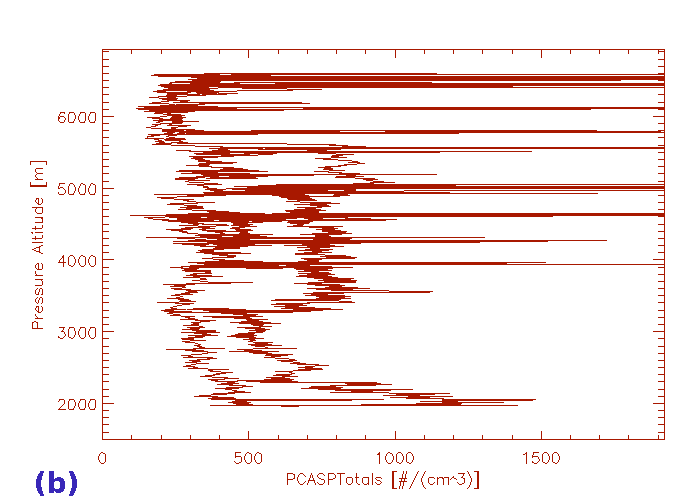Table of Contents
Cloud Condensation Nuclei Counter
- Manufacturer..: Droplet Measurement Technologies Inc.
- Model Number: CCN-100
Description
Cost
- Purchase: ~60,000 US$
Droplet Measurement Technologies Inc. version of this CCN counter system includes the CCN spectrometer, test cables, shipping case, one day of equipment usage training, one year warranty.
Calibration and maintenance cost varies from a couple of hundred to thousands American dollars according to the daily, monthly and yearly service schedule, and fine tune calibration of the instrument is done in DMT Inc. facilities.
Device Specifications
- Continuous flow, single supersaturation
- Cylindrical geometry, 50 cm column
- Longitudinal thermal gradient, continuous wetting
- Supersaturation range 0.1-2%
- 30 seconds supersaturation change, more than a minute for high-to-low SS changes
- Total flow 200-900, sample flow 20-90 volume cc/min
- Onboard computer for control and data logging
- Touch screen control and display
- Serial data output for external computer
- Multiple bin optical particle counting
- Sealed for operation on pressurized aircraft
- 28 Vdc power, 15A at startup, nominal 7A run current
- Rack mounting, 32 by 19 by 11 inches.
- Weighs 27 kg.
Principles of Operation
The single-column cloud condensation nucleus counter is also knows as a continuous-flow streamwise thermal-gradient chamber (CFSTGC.) The instrument is used to count the number of activated cloud particles in a sample air-flow. This commercialized design is based on the work of Roberts and Nenes (2004).
The core of the CCNC contains a vertical flow cylindrical flow tube (inner diameter 2.3 cm, length 50 cm). Aerosol sample flows in a laminar way from top to bottom of this tube near ambient pressure levels blanketed by filtered sheath air (total flow rate Q = 0.5-1 L/min, and sheath-to-aerosol flow ratio = 10.) The inner surface of the tube is continuously wetted with liquid water via a pump. Generally, the pump is operated at 4 mL/h water drip rate. Three thermal electric coolers (TEC) that are placed at the beginning, middle, and the end of outer wall of the tube help to create and control a positive temperature gradient in the stream-wise direction. During the aerosol flow, heat and water vapor are moved from the inner surface to the center of the tube, and since the vapor diffuses more quickly than heat, a constant supersaturation is established along the centerline.
Particles in the column that are having critical supersaturations less than the centerline supersaturation are activated as CCN. Activated particles grow into droplets and an optical particle counter that is at the exit of the column determines the size distribution of the droplets in 0.75 - 10 um size range.
Figure 1. Operational schematic diagram of the cloud condensation nucleus counter. (From Roberts and Nenes (2004)
Figure 2 summarizes the main operation of the instrument. The inner walls of the CCN column is continuously wetted, a temperature gradient is created inside the column. In the centerline, aerosol flow that is surrounded by the sheath flow is supersatured, and flowing particles grow into activated droplets.
Figure 2. Aerosol flow in the CCN counter column. Blue arrows show the direction of the water vapor flow, whereas red arrows show the heat flow from the walls of the column. (Courtesy of Dr. Athanasios Nenes, Georgia Institute of Technology)
Electronics
The preliminary test-version of the CCN counter uses an x86-compatible NEC v25 microcontroller as the main operation processing unit. The processor controls various components of the instrument via extensions boards. Temperature and pressure measurements are done through seven analog-to-digital inputs. Thermal electric coolers, pumps, and resistance heaters are controlled from eight digital-to-analog output channels. Data is stored on a PCMCIA media storage device, and RS-232 serial interface provides a bridge between the counter and data acquisition systems. User interface is provided via an LCD, and a keypad system. Despite the initial development version, the commercialized equipment ships with a Labview-based control and analysis software installed on a modern PC, and a touch screen monitor is used to ease of operation.
Optical Particle Counter
A MetOne optical particle counter (Model 9012) is located at the outlet of the CCN column. The OPC detects and sizes the activated droplets using standard scattering methods. The OPC uses a 780 nm, 30 mW wavelength photodiode laser. Activated particles are sized into six-bins (0.5 - 6.0 um), whereas the DMT version uses an improved OPC (size range: 0.75 - 10.0 um, and 20 size-selectable bins.) Sizing information is outputted via serial communication protocol at 1 Hz rate.
Main Features
- Fast sampling due to continuous flow (at least 1 Hz)
- Nearly constant supersaturation along the streamline
- The maximum supersaturation that is located at the centerline maximizes droplet growth.
- Supersaturation is a function of flow rate, pressure, and temperature.
- Cylindrical geometry minimizes buoyancy effects and helps droplets to grow detectable sizes.
- Different combinations of wall temperature gradients and flow rates can create the same supersaturation.
Field Projects
Due to the fact that cloud condensation nuclei has an important role during cloud formation and precipitation processes, many of atmospheric aerosol research campaigns include CCN measurements as a part of airborne and/or ground-based in-situ measurements. Below, three example field projects are given with a brief general project-target descriptions.
- International Consortium for Atmospheric Research on Transport and Transformation (ICARTT) (Summer 2004)
Measurements of CCN, aerosol size distributions, and chemical composition for better understanding of aerosol-cloud-climate interactions.
Figure 3. Layout of the aerosol size distribution (Scanning Mobility Particle Analyzer - SMPS), chemical composition (Aerosol Mass Spectrometer - AMS), CCN concentration (CFSTGC) measurement apparatus. (Schematic is courtesy of Medina et. al.)
- Kingdom of Saudi Arabia - Program for the Assessment of Rainfall Augmentation (KSAARA) (2006 - Present)
To understand the effects of cloud seeding in S. Arabia, and seek an answer to the problem of rainfall augmentation around the area.
Figure 4. Aerosol and CCN vertical profiles in Riyadh/Qassim/Hail region (Image was taken from KSAARA 2007-2008 Operational Summer Report (31 October 2008)
- Precipitation Augmentation Program and Research on Istanbul Clouds and Aerosols (PAPRICA) (Spring 2008)
To quantify and study aerosol effects on clouds and precipitation enhancement.
Figure 5. On the left image the orange line shows the aircraft track, and red, green, and blue lines correspond to NOAA HYSPLIT 72 hour back trajectories, the right image shows the CCN concentrations at 0.2%, 0.3%, and 0.6% supersaturation levels for March 20th 2008 case studies. (Images and information are courtesy of Duncan et. al.)
Documentation
The instrument ships with two manuals. Both CCN Counter Operator Manual (DOC-0086 Revision D), and Software Manual (DOC-0087 Rev B4) are located under /manuals directory in the /nas folder.
References
- D. Rose, S. S. Gunthe, E. Mikhailov, G. P. Frank, U. Dusek, M. O. Andreae, U. Pöschl (2008) Calibration and measurement uncertainties of a continuous-flow cloud condensation nuclei counter (DMT-CCNC): CCN activation of ammonium sulfate and sodium chloride aerosol particles in theory and experiment, Atmospheric Chemistry and Physics, 8, 1153-1179
- Lance, S., Medina, J., Smith, J.N., Nenes, A. (2006) Mapping the Operation of the DMT Continuous Flow CCN Counter, Aerosol Science and Technology, 40, 242-254
- Roberts, G., and Nenes, A. (2004) A Continuous-Flow Streamwise Thermal-Gradient CCN Chamber for Atmospheric Measurements, Aerosol Science and Technology, 39, 206–221
- Medina, J., Nenes, A., Sotiropoulou, R.E., Cottrell, L.D., Ziemba, L.D., Beckman, P.J., Griffin, R.J. (2007) Cloud Condensation Nuclei (CCN) closure during the ICARTT 2004 campaign: a) effects of size-resolved composition Journal of Geophysical Research, 112, D10S31
- Duncan, A., Teller A., Breed D., Collins D. R. (2008) Aerosol-cloud interactions over Istanbul, Turkey and central Saudi Arabia, 17th AMS/WMA Symposium on Planned & Inadvertent Weather Modification, Denver/Boulder,CO, April 21-25, 2008
Calibration
Method
Calibration of the CCN counter is done by measuring the activated aerosols of known composition and sizes, and comparing these results with Köhler theory. During the calibration process supersaturation of the device is kept fixed and particle activation degree is measured for different particle sizes.
An example calibration setup is shown in Figure 6. Calibration aerosols are generated by nebulazition of either sodium chloride or ammonium sulfate using an aerosol generator system. After the drying and charging processes of the polydisperse particles, the dry aerosol particles pass through a bipolar charger to form charge stability. Following this step the particles are size-classified by a differential mobility analyzer (DMA). Monodisperse particles is diluted with particle-free air to adjust the number concentration. After the dilution process, the aerosol flow is separated and introduced into a condensation particle counter (CPC), and into the CCN counter with the given flow rates as shown on Figure 6.
Figure 6. Calibration setup of the Cloud Condensation Nuclei Counter.
Two sample laboratory calibration experiment results are given in the following figures.
Figure 7. (a) shows CCN efficiency spectra (particle concentration ratios of the CCN counter and CPC vs. activation diameters) for 5 different ΔT (thermal gradient) values, (b) shows the calibration lines for these values. (Mainz, 21 December 2005, flow rate = 0.5 L/min, pressure = 1026 hPa, T1 = 298.5 K. Figures are from D. Rose et al. (2008)
Due to the multi-component nature of the CCN counter, it is also recommended to test and calibrate the fluid and gas flow, pressure levels, and the optical particle counter accuracy in and through the instrument. To maintain the correctness of the operations it is also recommended to run various daily and monthly maintenance checks.
Sources of Errors
Several important factors that effect the measurement performance of the CCN counter are given below:
- Particle loses in the instrument setup, and aerosol sampling inlets.
- Improper determination of activation threshold can cause undercounting or overcounting errors on the OPC data.
- Some specific micro-physical and chemical characteristics of aerosol particles
- During the calibration of the CCN counter, aerosol generator system can cause particle shape distortions.
- Since the supersaturation in the equipment is a function of flow rate, pressure, and temperature in the CCN counter column, making of high quality cloud condensation nuclei measurements is highly correlated with the well-establishing and controlling of these variables during the operation of the equipment.
Deployment
Deployment Platforms and Issues
The instrument could be deployed either on a ground base or an airborne platform. When the instrument is located on a pressurized aircraft, it must be ensured that the sample air inlet and outlet are both at ambient pressure to make reliable measurements. Also, the quality of 28 VDC input voltage must be maintained for not having troubles with the equipment in case of airborne deployment.
A positive thermal gradient is maintained between the top and bottom parts of the column during the operation of the CCN counter. High supersaturations are obtained with 20C or more temperature difference. For this reason, it is recommended to run the instrument at low environmental temperature levels.
As a part of the maintenance requirement of the instrument, it is best to refill the supply water with clean distilled water before the flight, and empty after each flight through the airborne application.
Figure 8. A CCN Counter and DMA deployed on an aircraft. (Courtesy of Dr. Don Collins from Texas A&M University.)
Figure 9. A DMT CCN counter (blue-framed part) and other aerosol measurementation instruments (From NOAA Aerosol, Radiation, and Cloud Processes Arctic Climate campaign laboratory, April 2008.)
The following figure shows the placement diagram of an atmospheric aerosol measurement system. As seen from the black-framed box, CCN Counter, DMA, and CPC almost always are deployed together, to establish the integrity of airborne measurements.
Figure 10. The layout of a complete aerosol and cloud physical and chemical property measurement platform (Platform was deployed on a F-ATR42 aircraft, during the EUCAARI IOP missions.)
Installation and Connections
The CCN must always be mounted in an upright-standing way. The majority of the internal components of the instrument is mounted with stainless steel fasteners to the aluminum back panel plate, and critical mounting screws are strengthened by using helicoil inserts.
Subsequent figures expose various power and data connection locations and points of the instrument, and brief explanations regarding to the important points are as follows:
- A military-style circular connector is used for power connection
- The power switch has a 20 A circuit breaker to protect the instrument for excessive loadings.
- Serial data is outputted via RS-232 protocol, in 9600 kbaud, 8-N-1 configuration.
- Sample inlet and exhaust ports use 1/4 inch Swagelok connections.
Figure 11. The highlighted portion of the left image shows where the instrument inputs and outputs locate, and corresponding back-view is shown on the right image.
Miniaturization
Various research has been going on to optimize the performance and miniaturize the instrument. For these purposes, the flow system, electronics control circuitry and the optical particle counter of the system were re-designed to improve the overall instrument performance. Low-power, reduced-size, high performance version of the device have been built as a result of the research work. Studies showed that the miniaturized version performs as well as its predecessor. The new design eases the aircraft-based field projects, and takes its place on lightweight unmanned aerial vehicles.
Table 1. Comparison of the commercialized and miniaturized version of the CCN counter. (Source: Joint Institute of the Scripps Institution of Oceanography web-page)
Figure 12. 4 years evolution of the CCN counter. From left-to-right; 1st prototype version (April 2002), 2nd version (January 2003), commercialized DMT version (July 2004), and miniaturized version. (August 2006)
Data Quality Control and Validation
During the operation of the instrument, numerous important variables are logged with a data acquisition system, besides the particle size distributions. These variables include: temperature readings from the thermal electric coolers, inlet, optical particle counter, and nafion, flow rates of sample and sheath flows, absolute pressure value, voltage and current outputs from laser, and the instrument itself.
A couple of methods could be applied to ensure the reliability of the CCN measurements. Supersaturation levels, and size concentrations are checked for their authenticity. Since supersaturation is a function of the thermal gradient, flow rate and pressure in the column of the instrument, these recorded values could be used to check the consistency of the theoretical and observed supersaturation levels. Before doing any analysis on CCN concentration the data must be verified for unrealistically high or low concentrations values due to an abnormal instrument behavior.
An example CCN concentration data is shown at Figure 13(a). Aerosol studies usually incorporates data from other aerosol measurement instruments such as FSSP and PCASP, chemical particle composition analysis instruments that are run concurrently with the CCN counter. An example the-same-flight PCASP concentration outputs are shown at Figure13(b). For further studies, satellite observations are combined with ground and airborne-based measurement results.
Figure 13. (a) Cloud droplet concentrations from a DMT CCN Counter, and (b) shows PCASP total particle concentrations at 0.1 - 3.0 um range. (Data from 08 August, 2008 KSAARA Project.)
